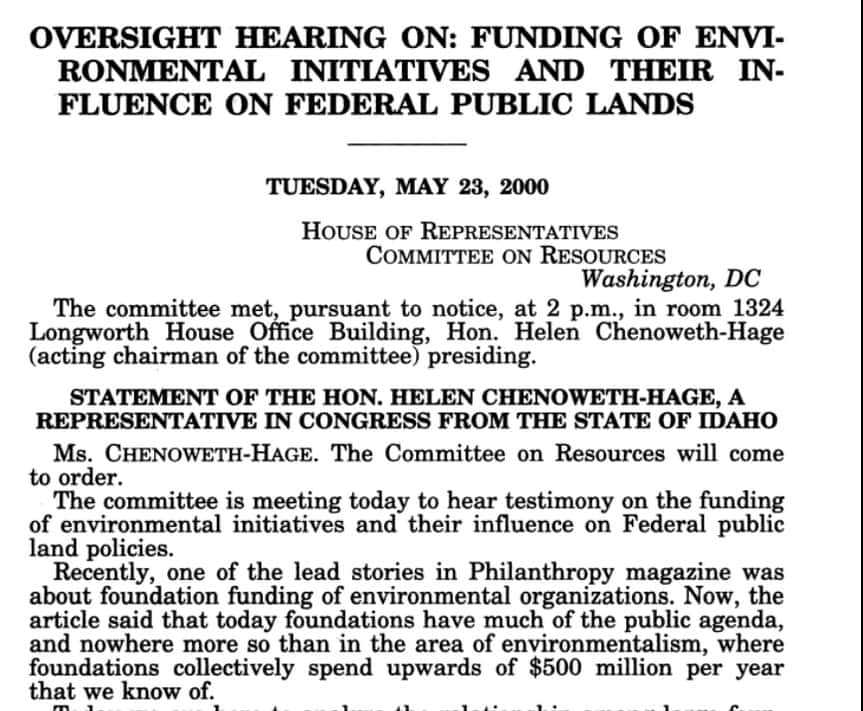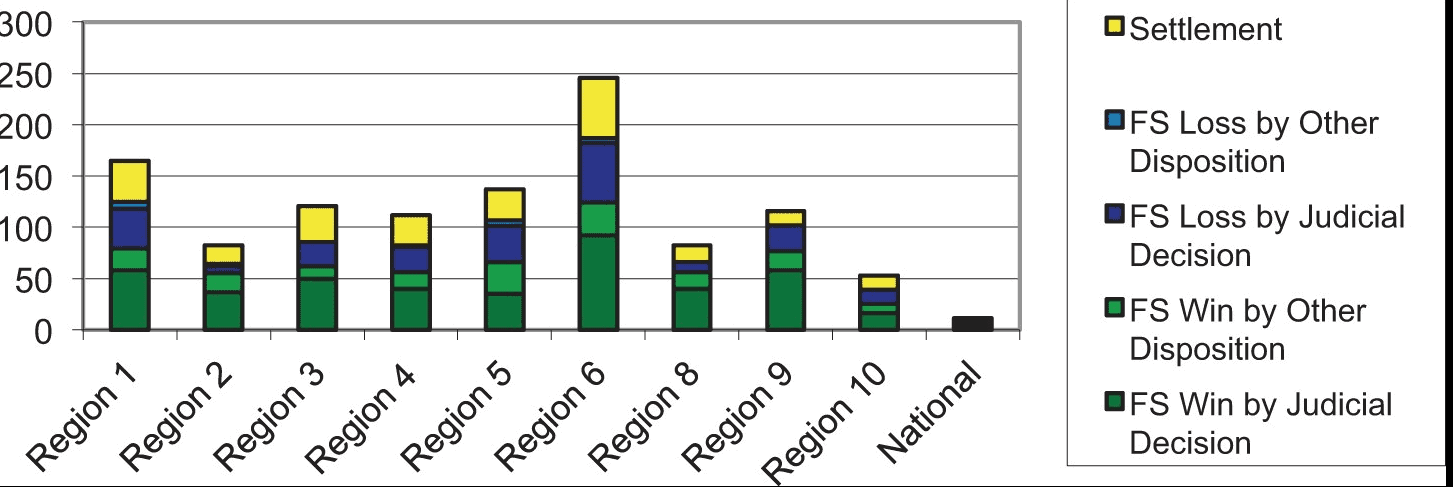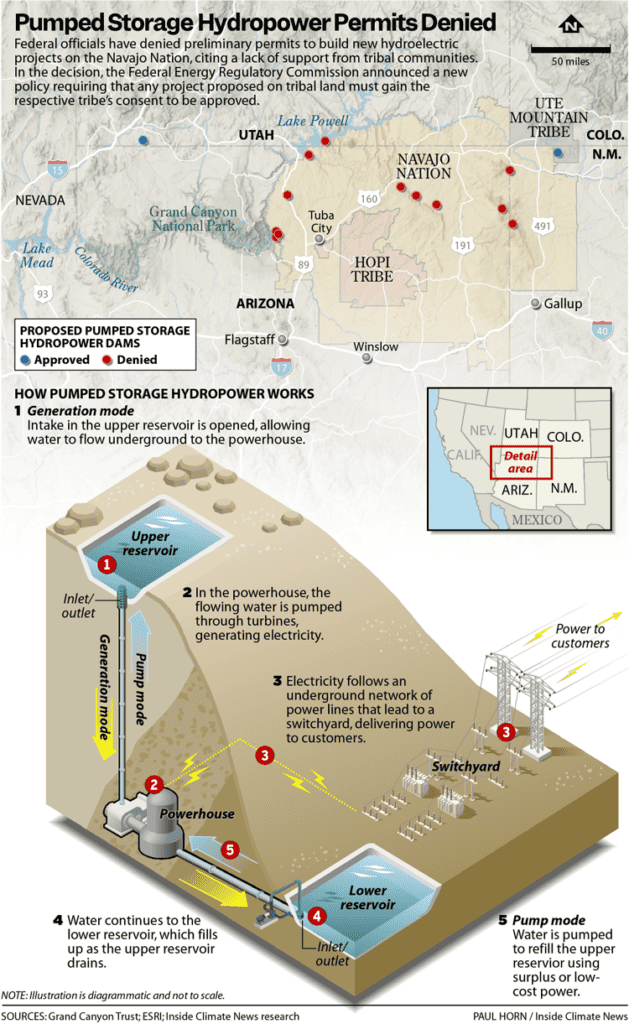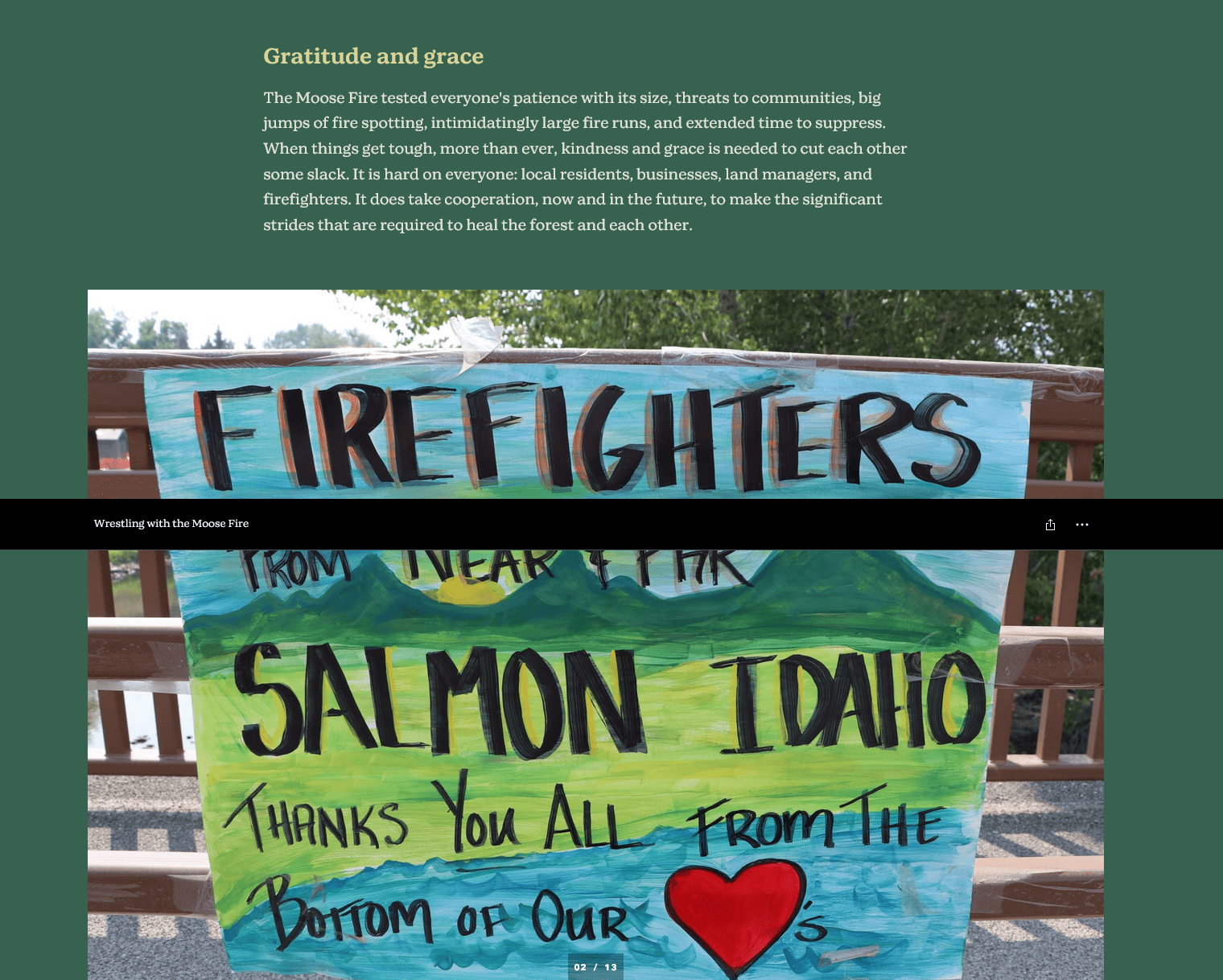One of the points I like to make about our forest policy world is that it is a great space for folks raising families and with other commitments. You can take a few years off (or possibly decades) and come back and not really miss much. Thanks to the TSW reader who found this hearing from the year 2000. If you swapped out “Climate Forest Campaign” for “Heritage Forest Campaign” and OG for Roadless, and Biden for Clinton-Gore, and probably increased the budget figures, it sounds like the same thing, and I think the questions asked are still worth pursuing. Sorry about the formatting. This is just Chenoweth-Hage’s introductory statement, I didn’t read the rest, there are 128 pages. Might be other interesting stuff there.
Recently , one of the lead stories in Philanthropy magazine wasabout foundation funding of environmental organizations . Now , thearticle said that today foundations have much of the public agenda ,and nowhere more so than in the area of environmentalism , wherefoundations collectively spend upwards of $ 500 million per yearthat we know of .
Today we are here to analyze the relationship among large foundations , environmental groups , and the Federal Government inFederal public land management policy , in regards to recreation , timber harvests , mining , and other public lands issues . We willalso explore the impacts of these policies on local communities . Environmental groups are relying more and more on a core ofwealthy , nonprofit foundations to fund their operations .
The largest environmental grantmaker – the $ 4.9 billion PewCharitable Trusts – gives more than $ 35 million annually to environmental groups . Other large wealthy foundations such as theTurner Foundation , W. Alton Jones , and Lucile and David PackardFoundations , are not far behind Pew in their grantmaking to environmental groups .
Foundations have funded environmental advocacy campaigns formore wilderness , curtailing timber harvests , and mining , breachingdams , and Federal control of ecosystem planning . An example ofthis type of activity is the Heritage Forest Campaign , the subjectof an oversight hearing on February 15 , 2000 , by the Subcommitteeon Forests and Forest Health .
The Heritage Forest Campaign , a coalition whose sole purposeappears to be lobbying the Clinton- Gore administration to implement the Roadless Initiative , which would withdraw up to 60 million acres of national forest lands from multiple use . This campaignis largely organized and funded by tax – free grants from charitablefoundations such as the Philadelphia based Pew Charitable Trusts ,with $ 4.9 billion in assets– the fifth largest U.S. charitable foundation .
Now , since September 1998 , Pew has given the National Audubon Society more than $ 3.5 million in tax – free grants to organizethe Heritage Forest Campaign , a coalition of about a dozen environmental groups . The sole objective of the campaign appears to bethe creation of widespread public support for the Clinton – Gore administration’s initiative to restrict access on 60 million acres of national forest lands .
The Heritage Forest Campaign illustrates several potential problems with foundation – financed environmental political advocacy ,namely the lack of fair , broad – based representation , and the absence of accountability . Particularly disturbing is this administration’s acquiescence to the campaign in the setting of policy .
At a recent hearing on the Roadless Initiative , I asked GeorgeFrampton , Director of the Council on Environmental Quality , forthe names of all those attending any meetings he had held regardinging the development of the Roadless Initiative . The list he sent inresponse is a who is who in the environmental community . Evenmore telling is that not one individual representing recreation , industry , academia , county commissioners , or local schools were inattendance . Only representatives of the national environmentalgroups participated .
Not only was the public excluded during these meetings , but sowas Congress . The administration’s Roadless Initiative appears tobe an attempt to bypass the role of Congress . Under Article IV ,Section 3 , of the United States Constitution , Congress possessesthe ultimate power over management and use of lands belongingto the United States .
If the Roadless Initiative is universally popular , why can’t theHeritage Forest Campaign get it enacted by Congress through thenormal legislative process ? Administrative directives , such as theRoadless Initiative , bypass Congress and centralize policymakingauthority within the hands of unelected bureaucrats in the execu-tive branch .
Foundation-funded advocacy groups make backroom deals , thusdenying the average citizen a voice and input into the policythrough their elected representatives in Congress . As a result , ourGovernment becomes more remote and unresponsive to the needsof the average citizen .
To whom is the Heritage Forest Campaign accountable? Thiscampaign is put together by foundations, not the participants . Thegrantees are accountable to the foundations that fund them , nottheir own members . Foundations have no voters , no customers , andno investors . The people who run big foundations are part of anelite and insulated group . They are typically located hundreds oreven thousands of miles from the communities affected by policiesthey advocate .
They receive little or no feedback from those affected by their decisions , nor are they accountable to anyone for promoting policieswhich adversely affect the well – being of rural people and localeconomies . Today’s witnesses will tell us how their communitiesare being crushed by an inaccessible and faceless movement , wielding great power and influence .
The role of large foundations in funding environmental advocacyraises some fundamental questions . Foundation wealth shapes public policy at the expense of all counter views . Even worse , thoseskeptical of foundation – supported policies are often smeared byfoundation –funded media campaigns in an attempt to marginalizethem in the debate . Even alternative environmental solutions arerejected out of hand as environmental groups mold their programsand their agenda to please the large grantmakers .
Does foundation – financed advocacy prevent full and fair publicdebate on public lands issues ? Is the average citizen’s voice andinput in the government decisionmaking process drowned out byfoundation – funded advocacy groups ?
The most fundamental question of all is , what happens to thetowns and communities affected by policies resulting from foundation – funded advocacy ? The people living in these communities areleft with a ruined local economy . Their towns lack the income toprovide even basic services . Their schools have no revenue to teachtheir children.
The important issue here is whether the foundation strategiesused to fund the environmental movement are buying undue influence for those groups on public lands policy . I believe it will becomevery clear during this hearing that this isn’t an issue concerningthe environment , but rather one concerning power and its use forpolitical ends , with rural communities being trampled in the process.
**********
Now, Rep. Chenoweth-Hage was appropriately concerned for rural communities as she represented Idaho. At the same time, today, these policies influence all kinds of communities near Federal lands. Another difference between then and now is our interest in the voices of Tribes, ethnic minorities and the poor and working class- marginalized communities. How are these folks (say folks from poor rural communities) represented on Boards and decision-making in these foundations?
“The important issue here is whether the foundation strategiesused to fund the environmental movement are buying undue influence for those groups on public lands policy.” IMHO this question is still valid.
Finally, what is the endgame of these foundations, if they have one? Is it the same old “no oil and gas drilling, no mining, no grazing, no commercial logging, no OHV’s”? I don’t know that we know, nor can I imagine who would have the political power to have that conversation.







